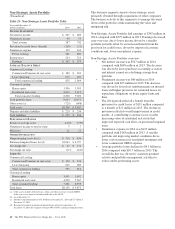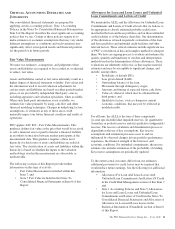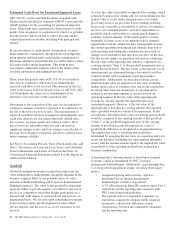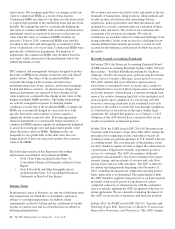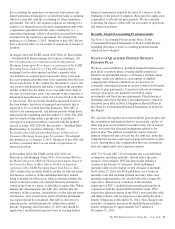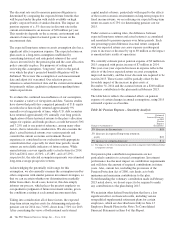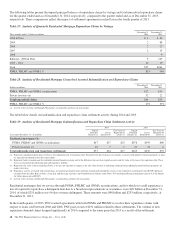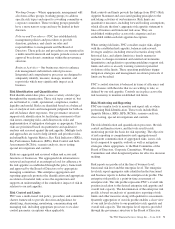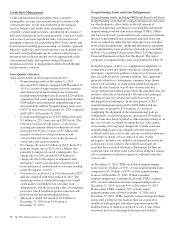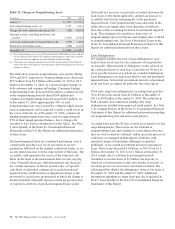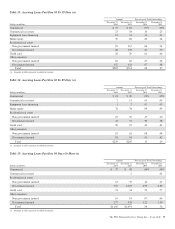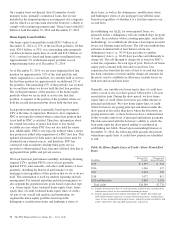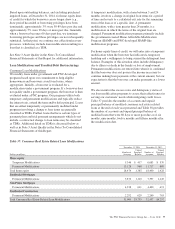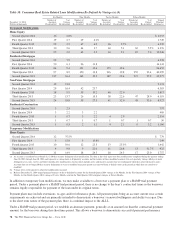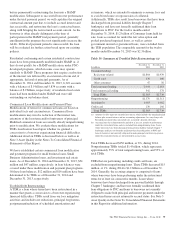PNC Bank 2014 Annual Report Download - page 88
Download and view the complete annual report
Please find page 88 of the 2014 PNC Bank annual report below. You can navigate through the pages in the report by either clicking on the pages listed below, or by using the keyword search tool below to find specific information within the annual report.Risk Appetite and Strategy
PNC manages risk in light of our risk appetite to optimize
long term shareholder value while supporting our employees,
customers, and communities. PNC’s risk appetite represents
the organization’s desired enterprise risk position, set within
our capital-based risk and liquidity capacity to achieve our
strategic objectives and business plans. Reviewed periodically
through the risk reporting and Strategic Planning processes,
the risk appetite serves as an operating guide for making
balanced risk decisions that support our business strategies; it
will adjust over time to reflect the current and anticipated
economic environment, growth objectives, risk capacity and
our risk profile.
We establish guiding principles for each of the risks within
our taxonomy to support the Risk Appetite Statement. The
guiding principles are qualitative statements that guide risk-
taking activities and are supported by quantitative metrics, risk
limits, and risk appetite descriptions as defined in policy and
managed through the ERM framework.
Risk Culture
All employees are considered risk managers, and are responsible
for understanding PNC’s Risk Appetite Statement, guiding
principles and ERM framework and how they apply to their
respective roles. PNC’s governance structure establishes clear
roles and responsibilities for risk management throughout the
organization. All employees are encouraged to collaborate
across groups to identify and mitigate risks and elevate issues as
required. PNC reinforces risk management responsibilities
through a performance management system where employee
performance goals include risk management objectives.
Incentives for eligible employees incorporate risk management
results through balanced measures of risk-adjusted performance.
Proactive communication, between groups and up to the
Board of Directors, facilitates timely identification and
resolution of risk issues. PNC’s multi-level risk committee
structure provides a formal channel to identify, decision, and
report risk. Risk committee membership includes
representatives from business and risk stakeholder groups that
are responsible for helping ensure risk issues are proactively
identified, decisioned, monitored, communicated and
managed appropriately within the enterprise risk management
framework.
Risk Organization and Governance
PNC employs a comprehensive risk management governance
structure to help ensure that risks are identified, balanced
decisions are made that consider risk and return, and risks are
adequately monitored and managed. Risk committees
established within this governance structure provide oversight
for risk management activities at the Board, corporate, and
business levels. Committee composition is designed to
provide effective oversight balanced across the three lines of
defense in accordance with the OCC’s heightened risk
management and governance expectations and guidelines. See
further discussion in the Supervision and Regulation section in
Item 1 of this Report. Within the three lines of defense, the
risk organization has sufficient authority to influence material
decisions. The Board oversees enterprise risk management of
PNC for any material changes to the risk profile and
periodically reviews core elements of enterprise risk including
the Risk Appetite Statement, Risk Capacity, Appetite and
Strategy, and Risk Controls and Limits.
We use our governance structure to assess the effectiveness of
our risk management practices on an ongoing basis, based on
how we manage our day-to-day business activities and on our
development and execution of more specific strategies to
mitigate risks. Specific responsibilities include:
Board of Directors – The Board oversees enterprise risk
management. The Risk Committee of the Board of
Directors evaluates PNC’s risk appetite, management’s
assessment of the enterprise risk profile, and the
enterprise-wide risk structure and processes established
by management to identify, measure, monitor, and
manage risk. The Audit Committee of the Board also has
responsibility for select areas of risk (e.g., Financial
Reporting, Ethics and Internal Controls over Financial
Reporting).
Corporate Committees – The corporate committees are
responsible for overseeing risk standards and strategies,
recommending risk limits, policies and metrics,
monitoring risk exposures, reviewing risk profiles and
key risk issues, and approving significant transactions
and initiatives. At the management level, PNC has
established several senior management-level committees
to facilitate the review, evaluation, and management of
risk. The management-level Executive Committee (EC)
is the corporate committee that is responsible for
developing enterprise-wide strategy and achieving PNC’s
strategic objectives. The EC evaluates risk management,
in part, by monitoring risk reporting from the other
corporate committees, which are the supporting
committees for EC.
Working Committees – The working committees are
generally subcommittees of the corporate committees and
include risk management committees for each of PNC’s
major businesses or functions. Working committees are
intended to define, design and develop the risk
management framework, including risk appetite, at the
business or function level. The working committees help
to implement key enterprise-level activities within a
business or function. These committees recommend risk
management policies for the business or function that are
consistent with the enterprise-wide risk management
objectives and policies. The business level committees
are also responsible for approving significant initiatives
under a certain threshold.
70 The PNC Financial Services Group, Inc. – Form 10-K


